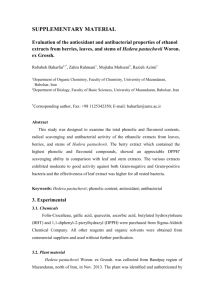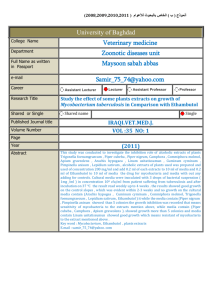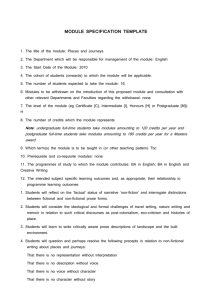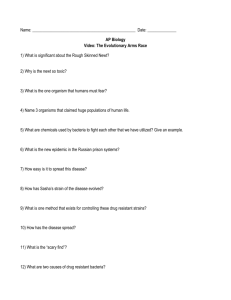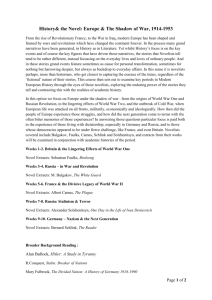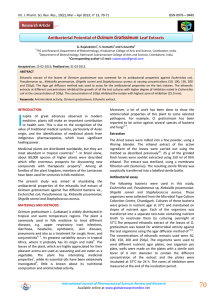antibacterial activity of herbal extracts against multi drug resistant
advertisement
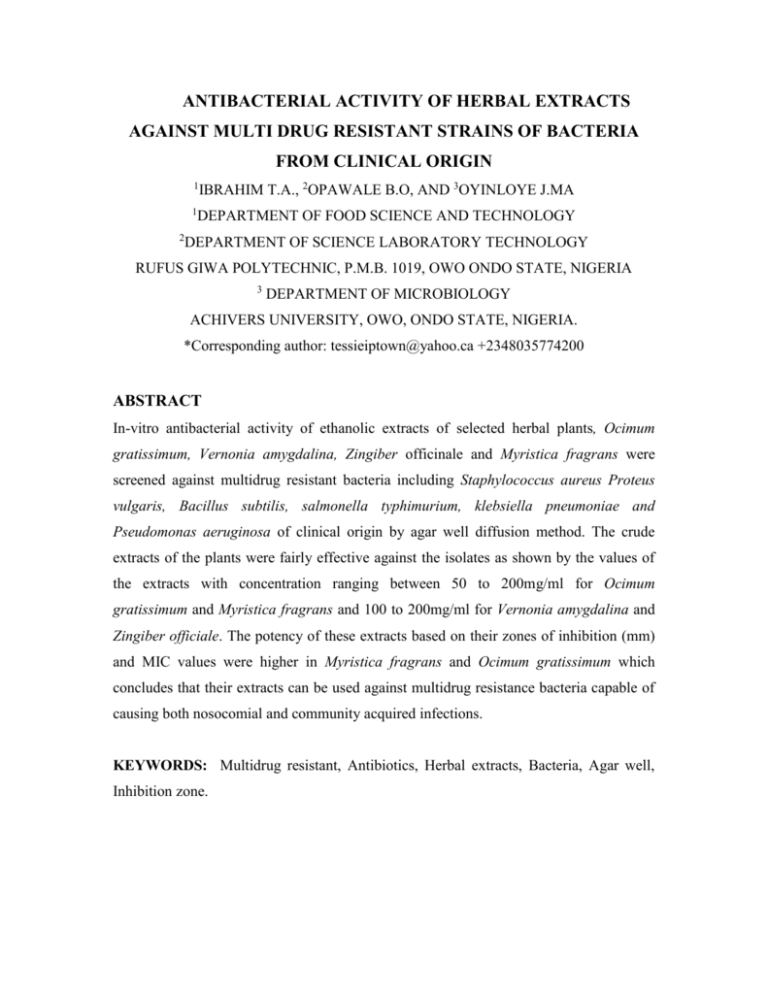
ANTIBACTERIAL ACTIVITY OF HERBAL EXTRACTS AGAINST MULTI DRUG RESISTANT STRAINS OF BACTERIA FROM CLINICAL ORIGIN 1 1 2 IBRAHIM T.A., 2OPAWALE B.O, AND 3OYINLOYE J.MA DEPARTMENT OF FOOD SCIENCE AND TECHNOLOGY DEPARTMENT OF SCIENCE LABORATORY TECHNOLOGY RUFUS GIWA POLYTECHNIC, P.M.B. 1019, OWO ONDO STATE, NIGERIA 3 DEPARTMENT OF MICROBIOLOGY ACHIVERS UNIVERSITY, OWO, ONDO STATE, NIGERIA. *Corresponding author: tessieiptown@yahoo.ca +2348035774200 ABSTRACT In-vitro antibacterial activity of ethanolic extracts of selected herbal plants, Ocimum gratissimum, Vernonia amygdalina, Zingiber officinale and Myristica fragrans were screened against multidrug resistant bacteria including Staphylococcus aureus Proteus vulgaris, Bacillus subtilis, salmonella typhimurium, klebsiella pneumoniae and Pseudomonas aeruginosa of clinical origin by agar well diffusion method. The crude extracts of the plants were fairly effective against the isolates as shown by the values of the extracts with concentration ranging between 50 to 200mg/ml for Ocimum gratissimum and Myristica fragrans and 100 to 200mg/ml for Vernonia amygdalina and Zingiber officiale. The potency of these extracts based on their zones of inhibition (mm) and MIC values were higher in Myristica fragrans and Ocimum gratissimum which concludes that their extracts can be used against multidrug resistance bacteria capable of causing both nosocomial and community acquired infections. KEYWORDS: Multidrug resistant, Antibiotics, Herbal extracts, Bacteria, Agar well, Inhibition zone. INTRODUCTION The wide use of antibiotics in the treatment o bacterial infections has led to the emergence and spread of resistant streams. The emergence of multiple drug resistant bacteria (MDR) has become a major cause of failure of the treatment of infections disease (Gibbons, 2005). As a result, society is facing one of the most serious public health dilemmas over the emergence of infection bacterial displaying resistance to many and in some cases, effective antibiotic (Kapil, 2005) much like the situation in human medicine, the use of antibiotics in agriculture, livestock and poultry has accelerated the development of antibiotic resistant strains of microbial pathogens, potentially complicating treatment for plants, animals and human (White et al, 2002). The continues spread of multdrug resistant pathogens has become a serious threat to public health and a major concern for infection control practitioners worldwide (Sander et al, 1992). In addition to increasing the cost of drug regimes this scenario has paved way for the re-emergency of the high frequency of opportunity and chronic infection cases in developing countries (Ako-nai et al, 2003). The slow pace of newer antibiotics development coupled with the availability of fewer antimicrobial actions centered on inhibition of ergosterol synthesis has provided the need to explore nature in search of phytotherapeutic agents work with novel targets and mode of actions. The practice of complementary and alternative medicine is now on the increase in developing countries in response to WHO directive culminating in several pre-scientific based for the efficacy of many plants used in folk medicine to treat infections (Dilhydy, 2003). Antibiotics provide the main basis for the therapy of microbial infection since the discovery of these antibiotics and their uses as chemotherapeutic agents there was a belief in the medical fraternity that this would lead to the eventual eradication of infection diseases (Rosina et al, 2009), However, overuse of antibiotics has become the major factor for the emergence and dissemination of multidrug resistant strains of several groups of micro-organisms (Harbottle et al, 2006). In the light of the evidence of rapid global spread of resistant clinical isolates, the need to find new antimicrobial agent is of paramount importance. However, the part record of rapid, wide spread emergence of resistance to newly introduced antimicrobial agents indicates investigate the antibacterial activity of ethanolic extracts of Ocimum gratisimum, Vernonia amygdalina, Zingiber officinale and Myristica fragrans against multi drug resistant strains isolated form community acquired infection. MATERIALS AND METHOD Plant materials collection: Fresh leaves of the plant materials (O.gratissimum, V. amygdalina, Z. Officinale, and M. fragrans) were collected from Isuada farm in Owo local Government Area, Ondo State. Identification and authentication were carried out in the herbarium section of Science Laboratory Technology Department of Rufus Giwa Polytechnic, Owo Ondo State. Preparation of Extracts: The leaves of the plants were air dried at room temperature for 3 weeks and grounded Ho coarse powder 50g of the powder was placed in 25ml of ethanol in conical flerk and kept in rotary shakes at 150pm for 24 hours. After 24hours, it was filtered and the solved evaporated. The ethanolic extracts were stored in sample bottles at 400C prior to use (De and Ifeoma, 2002). Sources of microorganisms: Clinical multiple antibiotic resistance strains of E.Coli (FMC 0312), Staphylococcus aureus (FM 0512), Proteus vulgaris (FMS 0146) Bacillus subtilis (FMC 0232) and Salmonella typhimurium (FMC0510),from community acquired infections were obtained from the Medical Microbiology Laboratory, Federal Medical center, Owo Ondo State. The isolates were maintained on nutrient agar and stored at 4oC prior to use. Standardization of inoculum: Exactly 0.2ml of 24hours old culture of each organism was dispensed into 20ml of sterile nutrient both and incubate for 35hours to standardize the culture to 106cfu/ml (Collins et al, 1995). Antibacterial Testing: This was done using the agar wells diffusion methods of Odeyemi and Fagbohun (2005). 0.5.ml overnight broth culture of each chemical isolates containing 106 cfu/ml was ascetically transferred to the solidified nutrient agar and spread evenly on the agar surface using a sterile glass spreader .Four 6mm wells were bored unto the agar and filled with the extract while the extracting solvent (ethanol) serves as control. The Petri dishes were incubated at 370C for 18-24hours and the inhibition zones were measured. Minimum Inhibition Concentration (MIC) of the Extract: The MIC was defined as the lowest concentration that completely incubated the growth of microorganisms for 24 hours (Thongson et al, 2004). The MIC of the extracts was also done using the agar well diffusion technique. A two fold dilution series was prepared to achieve a decreasing concentration range of 200 to 12.5% (V/V). A 0.5ml volume of each solution was added ascetically into he wells of Mueller Hinton agar plates that were already seeded with standardized inoculum (106 cfu/ml) of the bacterial isolates. The plates were incubated at 370C for 24hours. The lowest concentration of the extracts showing a clear zone of inhibition was considered as the MIC. RESULTS AND DISCUSSION Table 1 showed the antibiotic susceptibility of the bacterial isolated used for this research work. Twelve antibiotics of choice (Amikacin (AM), Cephalotrin (CF), Erythromycin (ET), Methicillin (MET), Norfloxacin (NOR), Tetracycycline (TT), Sulfonamide (SF), Ampicillin (AP), Gentamicin (GN), Sulfamethaxazole (SFT) and Kanamycin (KN) were used. Staphylococcus aureus was resistant to AM, CO, ET, MET, NOR, TT, SF and KN, E.coli was resistance to AM,AP,CF,CO,GN,TT and SFT, Klebriella pneumoniae was resistant to AM, Ap, CF, CO, NOR and TT, Pseudomonas aeruginosa was resisted to NA, AM, AP, CO, GN, KN, NOR, TT, SFI, Bacillus subtilis was resistant to AM, CF, CO, GN, KN, NOR, SFT, TT and Salmonella typhimurium was resistant to AP, and CF.Table 2 showed the susceptibility pattern of the crude ethanolic herbal extracts against the bacterial isolates. The extract of Myristica fragrans was the most effective extract showing the most antibacterial activity against all the isolates tested except fairly on Pseudomonas aeruginosa, Salmonella typhimurium and Bacillus subtitlis with inhibition zones (mm) of 0.2±0.12 and 0.1± 0.1 respectively, followed strictly were extracts of Zingiber officiale and Ocimum gratissium. The extracts were effective on all the best isolates except E.Coli Bacillus subtilis and Salmonella typhimurium. The least effective was ethanolic extract of Vernonia amygdalina. It showed low antibacterial actually on all the bacterial isolated except Staphylococcus aureus.Table 3 showed the minimum inhibitory concentration (MIC)of the crude extracts against multi-drug resistant baterial isolated. The extracts of Ocimum gratissimum inhabited the growth of E. coli klebsiella pneumoniae, Bacillus subtilis and Salmonella typhimuruim at 100 mg/ml while Proteus vulgaris, Pseudomonas aeruginosa and Staphylococcus aureus at 50 mg /ml. the extract of Vernonia amygdalina has the MIC of 100mg/ml for E.coli, Proteus vulgaris and Staphylococcus aureus while 200 mg/ml for klebsiella pneumoniae, Bacillus subtilis, Salmonella typhimurium, and Pseudomonas aeruginosa. The crude extract of Zingiber offianale inhibited the growth of E. coli and klebsiella pneumoniae at 100mg/ml Bacillus subtilis, Salmonella typhimurium and Pseudomonas aeruginosa at 200mg/ml while Staphylococcus aureus and Proteus vulgaris at 50mg/ml. Extract of Myristica fragrans has the MIC of 100 mg/ml for Bacillus subtilis Salmonella typhimurium, and Pseudomonas aeruginosa, 50mg/ml for E.coli, klebsiella pneumoniae, proteus vulgaris and 25mg/ml for Staphylococcus aureus. Plants have formed the basis of sophisticated traditional medicine system and natural products make excellent leads for new drug development (Newman et al, 2007). Approximately 80% of the word inhabitants rely on traditional medicine for their primary health care and play an important role in the health care system of the remaining 20% of the population. (Cragg et al; 1999). The word health organization (WHO) is encouraging, promoting and facilitating the effective use of herbal medicine in developing countries for health programs. The potential of higher unexplored hence last decade witnessed an increase in the investigation on plants as sources of new biomolecules for human disease management (Grierson and Afolayan, 1999). Even though, pharmacological industries have produced a number of new antibiotics in the last three decades, resistance to these drugs by microorganism has increased (Gislene, 2000). In general, bacteria have the genetic ability to transmit and acquire resistance to drugs which are utilized as therapeutic agents (Cohen ,2002).The problem of microbial resistance is growing and the outlook for the use of antimicrobial drugs in future is still uncertain. Therefore actions must be taken to reduce this problem, for example to control the use of antibiotics, develop research to better understand the genetic mechanism and to continue studies to develop new drugs either synthetic or natural. Various workers had worked on the antibacterial activity of the plants used on different medically important isolates but nor on multi antibiotic resistant strains. Recently, Ibrahim et al (2009) assessed the antibacterial activity of V.amygdalina and O.gratissimum leaves extract on selected food borne pathogens. The high zones of inhibition at low concentration proved the plants to be medically useful. Mbata and Saika (2008) tested the antibacterial activity of the extract of leaves of O.gratissimum on Listeria monocytogens.Their findings yielded great significance in health delivery system, since it could be used as an alternative treatment to orthodox antibiotics in the treatment of diseases caused by the bacterial isolates especially as the frequent develop resistance to known antibiotics and reduce the cost of obtaining health care as observed by Singleton (1999).Saxena et al (1994) documented antibacterial activity of these plants on selected gram positive and negative bacterial isolates Gislene et al (2000) showed that extracts of Z. officinale, M. fragrans, O. gratissimum, thyme, sage, rosemary, yarrow and guava showed antibacterial activity against antibiotic resistant bacteria such as P. aeruginosa, K. pnuemoniae, Proteus sp, Shigella sp.Suree and Pana (2005) found ethanolic extracts and essential oil of Zingiber officinale and Myristica fragrans to be effective against the Enterobatericae. Also Seher et al (2006) tested the methanolic extract of Z. officinale to be effective against Proteus sp, Bacillus sp, Staphyloccus sp, klebsiella sp, Listeria sp, Pseudomonas sp, and Streptococcus sp. Koshy et al (2009) found the ethanolic extract of Z. officinale and M. fragrans to be effective on Bacillus sp, Pseudomonas sp and Staphylococcus sp. The use of plant extract to treat infectious disease has been extensively applied by people. Literature and our research works revealed great potential of plant for therapeutic purposes in spite of the fact that they have not been completely investigated. Therefore, more studies need to be conducted to search for new antimicrobial compounds once extracted and used in new therapeutic treatments, they should have their toxicity in vivo. It is interesting to know that the extract were effective against Bacillus subtilis at 200mg/ml and 100mg/ml since those bacteria form resting spores and are more resistant to environmental conditions than any other tested bacteria in this work. E. coli and Pseudomonas aeruginosa were also inhibited by the extracts. E. coli has been known to be multi-drug resistant and P.aeruginosa which is very difficult to control by therapeutic means. In this study, the extracts showed considerable antibacterial activity against the MDR clinical isolates with the gram positive isolate Staphylococcus aureus (FMC0416) as the most susceptible while the gram negative were more resistant to the extracts. This was in line with the work of Burts (2004) that plants extracts and antibiotics are more effective against gram positive bacteria. It has been stated that the mechanism of the antimicrobial activity of the plant extract involves the inhibition of various cellular processes, increase in plasma membrane permeability and impairment of energy or synthesis of structural components in microbial cells(Walsh et al,2003).The varying degree of sensititivity of the bacterial strains may be due to the intrinsic tolerance of the bacterial and the nature and combinations of phytocompounds present in the extracts as observed by Suree and Pana (2005).Due to emergency of multiple antibiotic resistant pathogens in the hospitals and communities, plant extracts are being looked upon as an excellent remedy to combat this problem.The results of this work revealed that the extract of the plants showed considerable antibacterial activity against the MDR strains used where modern antibiotics failed even at low concentration range of 50 to 200mg/ml to control resistant bacteria which are becoming a threat to human health and minimizing the possible toxic effects. Table 1: Susceptibility pattern of crude ethanolic extract against Multiple Antibiotic Resistant Clinical Bacterial Isolates Diameter of inhibition zone (mm) Antibiotic Resistant Isolates O.gratissimum V.amygdalina Z.officinale E.coli (FMC0312) 0.00±0.00 0.1±0.00 0.00±0.00 0.4±0.00 Staphylococcus aureus (FMC0416) 0.3±0.11 0.4±0.10 0.6±0.00 0.8±0.10 Klebsiella pneumoniae (FMC0612) 0.2±0.00 0.2±0.10 0.3±0.00 0.6±0.00 Proteus vulgaris (FMC 0146) 0.2±0.10 0.3±0.10 0.4±0.00 0.6±0.00 Bacillus 0.1±0.00 subtilis(FMC0232) 0.00±0.00 0.00±0.00 0.2±0.10 Salmonella typhimurium (FMC0512) 0.1±0.00 0.1±0.01 0.00±0.00 0.1±0.10 Pseudomonas aeruginosa (FMC0512) 0.2±0.10 0.1±0.00 0.4±0.10 0.1±0.10 *Results are mean ± standard deviation of two replications M.fragrans Table 2: Minimum Inhibitory Concentration (MIC) of crude ethanolic extract against Multiple Antibiotic Resistant Clinical Bacterial Isolates. Bacterial Isolates Minimum Inhibitory Concentration (MIC) of crude ethanolic extract (mg/ml) O.gratissimum V.amygdalina Z.officinale M.fragrans 200 100 50 25 200 100 50 25 200 100 50 25 200 100 50 25 +v +v -v -v +v +v -v -v +v +v -v -v +v +v +v -v +v +v -v -v +v -v -v -v +v +v -v -v +v +v +v -v +v +v +v -v +v -v -v -v +v +v -v -v +v +v +v -v +v +v -v -v +v -v -v -v +v -v -v -v +v +v -v -v +v +v -v -v +v -v -v -v +v -v -v -v +v +v -v -v +v +v +v -v +v -v -v -v +v -v -v -v +v +v -v -v +v +v +v -v +v +v +v -v +v +v +v -v +v +v +v +v E.coli (FMC0312) Klebsiella pneumoniae (FMC0612) Proteus vulgaris (FMC 0146) Bacillus subtilis(FMC0232) Salmonella typhimurium (FMC0512) Pseudomonas aeruginosa (FMC0512) Staphylococcus aureus (FMC0416) Key: -v = negative (no growth) , +v = positive (growth) CONCLUSION The ethanolic extracts of the plants showed considerable antibacterial activity against the MDR bacterial strains used at low concentration of 50-200 mg/ml, thus can be used in the treatment of infectious disease caused by these MDR bacteria. REFERENCE Harbottle H, Thakure S,Zhao S, and white DG 2006. Genetics of antimicrobial resistance. Anim Biotechnol, 17:111-124. Coates A, Hue Y, Bax R, Page C 2002. The future challenges facing the development of new antimicrobial drugs. Nat Rev. Drug Discov 1:895-910. Bragh L.C., Leite A.AM, Xavier KGS,Takalashi J.A, Bemquerer M.P, ChartoneSouza E, Nascimento A.M. A 2005. Synergic interaction between pomegranate en tracts and antibiotics against Staphylococcus aureus. Can J. Microbial .51:541-547. Lee S.B., cha K.H, Kim S.N. Aintantsetseg S, Shator S, Sarangerel O, Nho C.W. 2007. The antimicrobial activity of essential oil from Dracocephalum foetidum against pathogenic microorganisms. J. Microbiol. 45:53-57. Hadi M, Faraz M, Shima P and Mahshid P 2006. Antibacterial activity of Thymes pubescens methanolic extract. Iranian J. of Pharmaceutical Research 7 (4) 291-295. Gibbons S. 2005. Plants as source of bacterial resistance modulators and anti infective agents phytochemistry Rev. 4:63-74). Kepil A 2005. The challenge of antibiotic resistance .Need to contemplate. Indian J. med Rev. 121:83-91 White DGS, Zhao S, Simgee S, Wanger DD and McDermott P.F 2002. Antimicrobial resistance of food borne pathogens. Microbes and Infection 4:405-412. Sanders CC and Sanders W.E 1992. β-Lactamase resistance in gram-negative bacteria:.global trends and clinical impact Clin. Infect. Dis. 15:824-835. Ako-Nai A.K, Ikem I C, Aziba A, Ajayi A.A and Onipede O.A 2003. Bacteriological Examination of Chronic Osteomyelitis cases in Ile-Ife, South Western Nigeria Afr. J.Clin. Exp. Microbiol. 4:41:51. Dilhuydy J.M 2003. Patients’ attraction to complementary and alternative medicine (CAM): a reality which physicians can neither ignore nor deny. Bull Cancer, 90:623-228. Rajendian N.K and Ramakrishnan J. 2009. Invitro evaluation of antimicrobial activity of crude extracts of medicinal plants against multidrug resistant pathogens BIBAD 2(2) 97-101. Diamond R.D 1993. The growing problem of myscoses in patients infected with human immunodeficiency virus. Rev. of Infect. Dis. 13-480-486. Hamborger M and Hosteltmann K 1991. Bioactivity in plants. The link between phytochemisrty and medicine. Phytochemistry 30:3864-3874. Basile A, Vuolto M.L. Lelpo M.T. 1998a. Antibacterial activity in Rhynchostegium ripariodes (Hedw) card extract (Bryophyta). Phytother Ress 12:146-148. De N and Ifeoma E. 2002. Antibacterial effects of components of the bark extracts of neem (Agadiracta indica , A. Juss). Technol. Dev. 8:23-28. Odebiyi A and Sofowora A.E. 1990. Phytochemical screening of Nigeria Medicinal Plants Part III. LLoydia, 41:234-246. Odeyemi A T and Fagbohun E.D 2005. Antimicrobial activities of the extracts of the peels of Dioscorea cyensis L. J f Appl and Environ. Sci. 1:37-42. Ibrahim T.A. Lola Ajala, Adetuyi F.O and Jude-Ojei B 2009. Assessment of the antibacterial activity of Vernonia amygdalina and Ocimum gratissimum leaves on selected food borne pathogens. The Internet Journal of Third World Medicine Vol 8 no 2. Collins C.H, Lynes P.M and Grange J.M 1995. Microbiological Methods, 7th ed. Butterwort, Heineman Ltd, Britain Pp 175-190. Rosina K, Barrira I, Mohd A, Shazi S, Anis A, Manazir S.A, Mashiatullah S and Asad U.K 2009. Antimicrobial activity of five herbal extracts against muti-drug reserve (MDR) strains of Bacteria and Fungi of clinical origin. Molecule 14:586-597, Walsh S.E. Maillard J.Y Russel A.D Catrenich C.E. Charbonneau A.L. Bartolo R.G. 2003.Activity and Mechanism of Action of selected Biocidial Agents on gram positive and negative bacteria J. Appl .Microbiol. 94:240-247. Singleton V.L. Orthofer, and Lamuela Raventos R.M 1999. Analysis of total phenols and other oxidation substrates and antioxidants by means of Folin cioalteau Regents methods Enzymol. 299:152-178. Cohen M.L 2002. Changing patterns of infection diseases. Nature 406:762-767. Koshy P, Sri-Nurestri A,M Wira Karnain S, Sim K.S, Saravana K, Hong S.L. Lee G.S and Syarifat N.S.A 2009. Antimicrobial activity of some medicinal plants from Malaysia American J. of Appl. Sci. 6 (8): 1613-1617. Sehler G, Dilek T. B and Nazmi G. 2006 .Antimicrobial activity and some fathy acids of turmeric, ginger root and limseed used in the treatment of infection diseases. World Journal of Agricultural Science (4):439-442 Gislene G.F, Juliana L, Paulo C.F and Giuliana L.S 2000. Antibacterial activity of plant extracts and phytochemicals on Antibiotic Resistant Bacteria. Brazilian Journal of Microbiology 31,247-256. Saxena G, McCtchea ,A.R, Farma S,Tower G.H.N and Hancock R.E.N1994. Antimicrobial Constituents of Rhus glabra. J. Ethnopharmocol 42, 95-94. Surer N and Pana L. (200. Antibacterial activity of crude ethanolic extracts and essential oils of spices against Salmonellae and other Enterobacteriacea. KMITL Sci. Tech. J. Vol. 5 No 3 Pp 527-538. Mbata T. I and Saikia A. 2008. Antibacterial Activity and phytochemical screening of crude ethanol extract of leaves of Ocimum gratissimum on Listeria monocytogenes .The Internet Journal of Microbiology, Vol. 40 2 pp 1-13 Newman D.J, Cragg G.M and Snader K.M 2000. The influence of natural products upon drug discovery.Natural product Res. 17:215-234. Cragg G.M, Boyd M.r, Khanna R, Kneller R, Mays T.D, Mazan K.D, Newman D.J. and Sausville E.A 1999. International Collaboration in drug discovery and development, the NCT experience. Pure Appl. Chem. 71-1619-1633. Grierson D.S and A.J. Afolayan 1999 .Antibacterial activity of some indigenous plants used for the treatment of wounds in the Eastern cape, South Africa J. Ethnopharcol 66:103-106. Burt S. 2004.Essential Oils: their antibacterial properties and potential application in foods- a review. International J of Food Microbiology, 94: 223-253.


